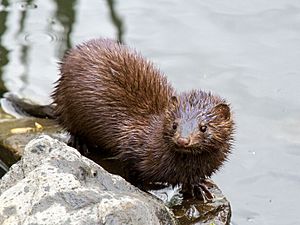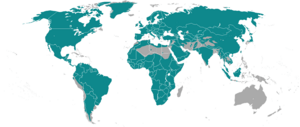Mustelinae facts for kids
Quick facts for kids Mustelinae |
|
|---|---|
 |
|
| American mink | |
| Scientific classification |
|
| Kingdom: | Animalia |
| Phylum: | Chordata |
| Class: | Mammalia |
| Order: | Carnivora |
| Family: | Mustelidae |
| Subfamily: | Mustelinae G. Fischer de Waldheim, 1817 |
| Genera | |
|
|
 |
|
| Mustelinae range | |
The Mustelinae is a big group of animals that are part of the mustelid family. Think of them as a large branch on the mustelid family tree! This group includes many animals you might know.
Scientists are always learning more about how these animals are related. For now, the Mustelinae group includes:
And many other cool mustelids!
Contents
What are Mustelids?
Mustelids are a family of meat-eating mammals. They are known for being quick and clever hunters. Most mustelids have long, slender bodies. They also have short legs and thick fur.
Many mustelids are found all over the world. They live in different habitats. This includes forests, grasslands, and even near water.
Common Mustelinae Animals
Let's look at some of the animals in the Mustelinae group.
Weasels
Weasels are small, quick hunters. They have long, thin bodies. This helps them chase prey into small burrows. Weasels mostly eat small rodents like mice. They are very fast and agile.
Minks
Minks are mustelids that love water. They are excellent swimmers. Minks often live near rivers, lakes, and streams. They hunt fish, frogs, and small mammals. Their fur is very soft and dark.
Wolverines
Wolverines are the largest land-dwelling mustelids. They are known for being very strong and fierce. Wolverines live in cold, northern areas. They can hunt animals much larger than themselves. They also eat carrion (dead animals).
Martens
Martens are tree-dwelling mustelids. They are very agile climbers. Martens live in forests. They hunt squirrels, birds, and other small animals. They have bushy tails and soft fur.
Badgers
Badgers are strong, burrowing mustelids. They have powerful claws for digging. Badgers live in underground tunnels called "setts." They mostly eat worms, insects, and small animals. Some badgers are social and live in groups.
Polecats
Polecats look a bit like ferrets. They are known for a strong smell they can release. This smell helps them defend themselves. Polecats hunt rodents and birds. They are mostly active at night.
Stoats
Stoats are similar to weasels but a bit larger. In winter, their fur can turn white in cold regions. This helps them blend into the snow. They are also very skilled hunters.
Habitat and Diet
Mustelinae animals live in many different places. You can find them in forests, mountains, and even deserts. Some live near water, like minks. Others prefer open fields or rocky areas.
Most Mustelinae are carnivores. This means they eat meat. Their diet includes:
- Small mammals (like mice and rabbits)
- Birds and their eggs
- Fish and frogs
- Insects and worms
Some, like badgers, also eat plants or berries. They are important parts of their ecosystems. They help control populations of other animals.
Reproduction and Life Cycle
Mustelinae animals usually have their babies in dens. These dens can be in hollow logs, rock crevices, or underground burrows. The number of babies varies by species. Some have just a few, while others have many.
The young are born helpless. Their mothers care for them. They teach them how to hunt. The young grow quickly. They soon become independent. They then go off to find their own territories.
Images for kids
See also
 In Spanish: Mustelinos para niños
In Spanish: Mustelinos para niños


